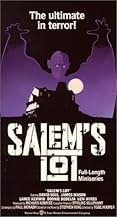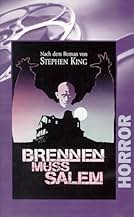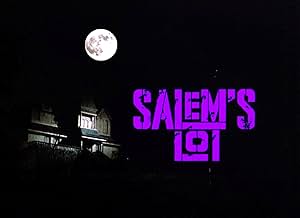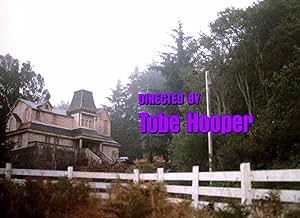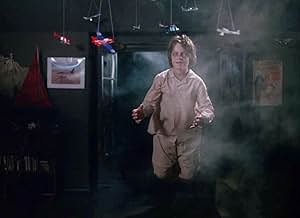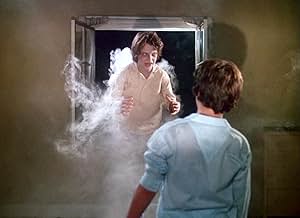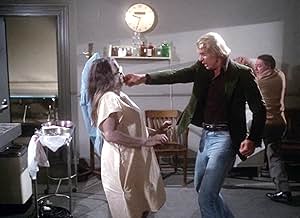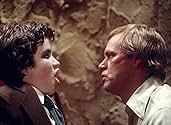Un novelista y un joven aficionado a las historias de terror intentan salvar una pequeña ciudad de Nueva Inglaterra que ha sido invadida por vampiros.Un novelista y un joven aficionado a las historias de terror intentan salvar una pequeña ciudad de Nueva Inglaterra que ha sido invadida por vampiros.Un novelista y un joven aficionado a las historias de terror intentan salvar una pequeña ciudad de Nueva Inglaterra que ha sido invadida por vampiros.
- Nominado a 3 premios Primetime Emmy
- 4 nominaciones en total
Explorar episodios
Opiniones destacadas
I recently read Stephen Kings novel (one of his first major successes), so I thought of checking out this mini-series. It's by now more than 40 years old, and that of course shows. The pace is slower than we are now used to (the overlong almost three and a half hours didn't help with that) and the special effects are modest.
But director Tobe Hooper created a pleasantly creepy atmosphere, building up the tension gradually but very effectively; the photography is at times great (the scene of the undertaker on the graveyard for instance); the eerie musical score is exactly right; and there is some solid acting, especially by David Soul and by old school actor James Mason, who excels in his aloof and over-civilized attitude. Some scenes, like the floating vampires by the windows, now make a rather simple impression, but the make-up of the master vampire, like a Nosferatu in colour, is absolutely top-notch scary!
The series follows the novel pretty closely, they only brought back the amount of characters a bit, probably to keep everything more surveyable. The epilogue is essentially different from the book and comes a bit out of the blue, but as an (open) closure to the movie it worked fine enough.
But director Tobe Hooper created a pleasantly creepy atmosphere, building up the tension gradually but very effectively; the photography is at times great (the scene of the undertaker on the graveyard for instance); the eerie musical score is exactly right; and there is some solid acting, especially by David Soul and by old school actor James Mason, who excels in his aloof and over-civilized attitude. Some scenes, like the floating vampires by the windows, now make a rather simple impression, but the make-up of the master vampire, like a Nosferatu in colour, is absolutely top-notch scary!
The series follows the novel pretty closely, they only brought back the amount of characters a bit, probably to keep everything more surveyable. The epilogue is essentially different from the book and comes a bit out of the blue, but as an (open) closure to the movie it worked fine enough.
This movie is an odd cross between "Peyton Place" and "Nosferatu"...and it works! Set in the small, isolated and somewhat inbred community of Jerusalems Lot (called Salems Lot by the locals) this film is more about small town dirty secrets which are really not secret at all. Everyone knows everyone else's business, gossip is a way of life and the town's mistrust of outsiders is both expected and justified when two men show up in town and a little boy goes missing. This is a story about a small town that just happens to have a vampire in it.
James Mason is elegance personified as the "Renfield" character who sticks out like a sore thumb in this tight-knit community and makes himself the object of suspicion when he moves into the local haunted house and opens up an antique shop. His European accent, expensive suits and somewhat prissy manners make him a hot item of gossip. So too does the arrival of Ben Mears also cause local tongues to start wagging. Mears was born and raised in Salems Lot, having moved away as a small child. He returns as a semi-successful author and a recent widower, haunted by childhood memories of the Marsten House - the local haunted house in which James Mason now resides. Yet another outsider is Mark, a new teen in town with a morbid collection of horror movie paraphernalia. These three characters are drawn together by force as more people go missing and the small town residents, with their narrow vision, cannot accept what is really happening. It is up to the outsiders - the author who knows, the teenager who believes and the human who is a monster - to solve the mystery.
When the vampire finally appears, it is a frightening, exhilarating experience. Reggie Nalder as Barlow, the ancient Master whom James Mason serves, is a disgusting parasite, a physical homage to Nosferatu with his rat-like teeth, his long bony fingers and his hypnotic eyes. He is the frosting on the cake for this excellent film. By the time he makes his appearance, it is almost unnecessary. The paranoia has already decimated the town, and the fear of the unknown is the greatest monster of all. But though he may be unnecessary, he is not unwelcome. He is a wonderful vampire, a truly hideous beast, a fine salute to what a vampire should be - ugly, vile and obscene.
This is one of my all time favorite vampire films, right up there with Nosferatu and Subspecies. To hell with whining, pretentious vampire Pretty Boys - this is the real stuff, and it doesn't get much better than this.
James Mason is elegance personified as the "Renfield" character who sticks out like a sore thumb in this tight-knit community and makes himself the object of suspicion when he moves into the local haunted house and opens up an antique shop. His European accent, expensive suits and somewhat prissy manners make him a hot item of gossip. So too does the arrival of Ben Mears also cause local tongues to start wagging. Mears was born and raised in Salems Lot, having moved away as a small child. He returns as a semi-successful author and a recent widower, haunted by childhood memories of the Marsten House - the local haunted house in which James Mason now resides. Yet another outsider is Mark, a new teen in town with a morbid collection of horror movie paraphernalia. These three characters are drawn together by force as more people go missing and the small town residents, with their narrow vision, cannot accept what is really happening. It is up to the outsiders - the author who knows, the teenager who believes and the human who is a monster - to solve the mystery.
When the vampire finally appears, it is a frightening, exhilarating experience. Reggie Nalder as Barlow, the ancient Master whom James Mason serves, is a disgusting parasite, a physical homage to Nosferatu with his rat-like teeth, his long bony fingers and his hypnotic eyes. He is the frosting on the cake for this excellent film. By the time he makes his appearance, it is almost unnecessary. The paranoia has already decimated the town, and the fear of the unknown is the greatest monster of all. But though he may be unnecessary, he is not unwelcome. He is a wonderful vampire, a truly hideous beast, a fine salute to what a vampire should be - ugly, vile and obscene.
This is one of my all time favorite vampire films, right up there with Nosferatu and Subspecies. To hell with whining, pretentious vampire Pretty Boys - this is the real stuff, and it doesn't get much better than this.
As it really is a wonderful and suspenseful vampire tale! Stephen King - not normally my favorite horror writer - has created one of the absolute BEST modern vampire tales in this story, and this mini-series translation is absolutely true to the feel of his tale! Instead of splatterfest effects , this show hinges itself on a high-tension spiderweb of plotlines and sets up the vampire more as a behind-the-scenes controlling evil. The terror here is not in seeing the monster, it is in NOT seeing him and knowing that he and his minions are out there, somewhere, plotting and planning with the heros stumbling blindly after them like toddlers in the dark. Give this show a chance! It may just scare you!
First let me suggest to see the original miniseries version if at all possible. The "movie" version is horribly chopped. The remaining pieces don't fit together and leave gaping holes (such as, "what happened to Susan?")
Salem's Lot is an almost unknown milestone in horror films. This superb combination of the talents of Tobe Hooper and Stephen King bridges the gap between the Hammer-style films of the 60's and the modern vampire films. Two things to especially note:
(1) This takes place in Everytown, USA and the cinematography reflects the ordinary turned extraordinary (which is the same effect achieved by Bram Stoker's original writing for the audience of his time.) It begins looking almost like a Rockford Files episode and goes dark from there. But even the climax in the evil Marsten house looks *real*, just as you would imagine an old decrepit house to look. You can almost smell the dust. Hey, this was the seventies, the decade of naturalistic lighting. Everything coming out of Hollywood now looks just that - like Hollywood.
(2) It is a shame that anyone today viewing Salem's Lot already knows that is about vampires because when it first aired on TV, the unknown aspect is what made the first half so creepy. Now you just sit there waiting for the vampires to show up. (If I thought that even one person might read this without knowing it was about vampires, I wouldn't write this.) The advertising for the show made no mention of vampires and the effect worked well. I was ten years old when I first saw this. I had seen at least a dozen other vampire flicks - Noseratu, Lugasi, the Hammer films - and I had no clue that this was about vampires. All I knew was that something creepy was going in this town and it was getting creepier and creepier. Only in the second episode when you see someone get bit in the neck did it finally click, "Oh my god, they're vampires." You realize it right about the same time that the main characters do. Highly effective.
Also, superb performances by David Soul, Lew Ayres, James Mason.
Salem's Lot is an almost unknown milestone in horror films. This superb combination of the talents of Tobe Hooper and Stephen King bridges the gap between the Hammer-style films of the 60's and the modern vampire films. Two things to especially note:
(1) This takes place in Everytown, USA and the cinematography reflects the ordinary turned extraordinary (which is the same effect achieved by Bram Stoker's original writing for the audience of his time.) It begins looking almost like a Rockford Files episode and goes dark from there. But even the climax in the evil Marsten house looks *real*, just as you would imagine an old decrepit house to look. You can almost smell the dust. Hey, this was the seventies, the decade of naturalistic lighting. Everything coming out of Hollywood now looks just that - like Hollywood.
(2) It is a shame that anyone today viewing Salem's Lot already knows that is about vampires because when it first aired on TV, the unknown aspect is what made the first half so creepy. Now you just sit there waiting for the vampires to show up. (If I thought that even one person might read this without knowing it was about vampires, I wouldn't write this.) The advertising for the show made no mention of vampires and the effect worked well. I was ten years old when I first saw this. I had seen at least a dozen other vampire flicks - Noseratu, Lugasi, the Hammer films - and I had no clue that this was about vampires. All I knew was that something creepy was going in this town and it was getting creepier and creepier. Only in the second episode when you see someone get bit in the neck did it finally click, "Oh my god, they're vampires." You realize it right about the same time that the main characters do. Highly effective.
Also, superb performances by David Soul, Lew Ayres, James Mason.
This is one of the most richly atmospheric films in horror, an article of pure latenight seduction and phosphorescent darkness.
Atmospheric not in the sense that a dry ice machine has pumped a catacomb full of haze and cobwebs are strategically placed in some dark corner, but as a place lived, with naturally dark corners and tangible portents: the old dark house on the hill breathing evil, the antique shop downtown, all velvety smell and musty colors, the small town lined with porticoes bathed in the quiet of a lazy night, yet harboring secrets and vice from inside. Prying eyes staring from behind a curtain.
Oh, at some point vampires come flying through the window, and it's still fine by me, it's one of the better vampire films and at 3 hours it's better fleshed than most of them; but I am just not attuned to the whole vampire lore so I leave this part to be enjoyed best by the traditional horror fan. It is actually one of the more potent retellings of the most familiar story in this field, I was pleasantly surprised to see that it was not quite Dracula but that older film with longer shadows, so I will not spoil the discovery for you.
But the first part intrigues me in stranger ways, more suggestive, with menace that goes unspoken. The small-town facade that would later resurface in Twin Peaks.
There is a notion that matters in all this, but which is not pursued at all; the writer who feels from his perspective that it was his presence that awakened evil, it's fitting that it's coming from a writer because it's a self-centered, imaginative notion, but which from our end we know is bogus. Evil was already afoot, and was never centered around him. But he wistfully imagines himself at the center so he can write about it.
So I don't know what happened with Tobe Hooper. He was never very elegant with a camera, the way Argento was or occasionally Carpenter, but he was unmatched in his feel for the aural qualities of film. He could make a room hum with evil. My guess is that, being an intuitive maker, the feel came and went, or he forgot how to tap into it (you can see as early as Eaten Alive how he seems to be desperately trying to capture again the muse that gave him Texas Massacre). Or he plainly stopped actively chasing after the right material.
This was just right for him. Only Kubrick has better adapted Stephen King to my mind.
Atmospheric not in the sense that a dry ice machine has pumped a catacomb full of haze and cobwebs are strategically placed in some dark corner, but as a place lived, with naturally dark corners and tangible portents: the old dark house on the hill breathing evil, the antique shop downtown, all velvety smell and musty colors, the small town lined with porticoes bathed in the quiet of a lazy night, yet harboring secrets and vice from inside. Prying eyes staring from behind a curtain.
Oh, at some point vampires come flying through the window, and it's still fine by me, it's one of the better vampire films and at 3 hours it's better fleshed than most of them; but I am just not attuned to the whole vampire lore so I leave this part to be enjoyed best by the traditional horror fan. It is actually one of the more potent retellings of the most familiar story in this field, I was pleasantly surprised to see that it was not quite Dracula but that older film with longer shadows, so I will not spoil the discovery for you.
But the first part intrigues me in stranger ways, more suggestive, with menace that goes unspoken. The small-town facade that would later resurface in Twin Peaks.
There is a notion that matters in all this, but which is not pursued at all; the writer who feels from his perspective that it was his presence that awakened evil, it's fitting that it's coming from a writer because it's a self-centered, imaginative notion, but which from our end we know is bogus. Evil was already afoot, and was never centered around him. But he wistfully imagines himself at the center so he can write about it.
So I don't know what happened with Tobe Hooper. He was never very elegant with a camera, the way Argento was or occasionally Carpenter, but he was unmatched in his feel for the aural qualities of film. He could make a room hum with evil. My guess is that, being an intuitive maker, the feel came and went, or he forgot how to tap into it (you can see as early as Eaten Alive how he seems to be desperately trying to capture again the muse that gave him Texas Massacre). Or he plainly stopped actively chasing after the right material.
This was just right for him. Only Kubrick has better adapted Stephen King to my mind.
Stephen King Movies Ranked by IMDb Rating
Stephen King Movies Ranked by IMDb Rating
See how IMDb users rank the feature films based on the work of Stephen King.
¿Sabías que…?
- TriviaThe exterior for the Marsten House was actually a full-scale facade built upon a smaller pre-existing hill-top house. In total, the facade cost the production an estimated $100,000 dollars to build. In 1979, an entire house (including the interiors) could have been made for that amount.
- ErroresWhen the younger Glick brother is abducted (and later presumably murdered by Barlow) he's wearing a jacket, t-shirt, dungarees and sneakers. After which, he appears to his brother wearing pajamas.
- Créditos curiososThe text of the opening credits appear and dissolve piece by piece into each other in a jigsaw puzzle fashion.
- Versiones alternativasSalem's Lot originally aired as a two-night mini-series with the first episode airing on 17 November 1979 and the second episode airing the following week on 24 November 1979.
- ConexionesFeatured in Stairs (1986)
Selecciones populares
Inicia sesión para calificar y agrega a la lista de videos para obtener recomendaciones personalizadas
Detalles
- Fecha de lanzamiento
- País de origen
- Idioma
- También se conoce como
- Blood Thirst
- Locaciones de filmación
- 850 Bluff Street, Ferndale, California, Estados Unidos(Marsten House)
- Productora
- Ver más créditos de la compañía en IMDbPro
Contribuir a esta página
Sugiere una edición o agrega el contenido que falta


